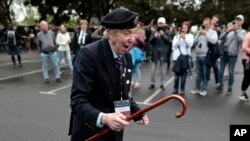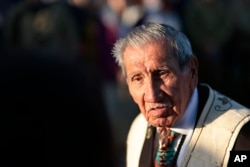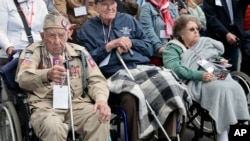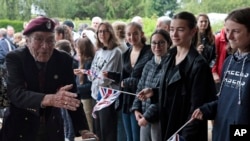When D-Day veterans set foot on the Normandy beaches and other World War II sites, they express a mix of joy and sadness. Joy at seeing the gratitude and friendliness of the French toward those who landed on June 6, 1944. Sadness as they think of their fallen comrades and of another battle now being waged in Europe: the war in Ukraine.
For the past two years, D-Day ceremonies were reduced to a minimum amid COVID-19 lockdown restrictions.
This year, crowds of French and international visitors — including veterans in their 90s — were back in Normandy for the 78th D-Day anniversary to pay tribute to the nearly 160,000 troops from Britain, the U.S., Canada and elsewhere who landed there to bring freedom.
Several thousand people were expected Monday at a ceremony at the American Cemetery overlooking Omaha Beach in the French town of Colleville-sur-Mer. Amid the dozens of U.S. veterans expected to attend was Ray Wallace, 97, a former paratrooper with the 82nd Airborne Division.
On D-Day, his plane was hit and caught fire, forcing him to jump earlier than expected. He landed 20 miles (32 kilometers) away from the town of Sainte-Mere-Eglise, the first French village to be liberated from Nazi occupation.
“We all got a little scared then. And then whenever the guy dropped us out, we were away from where the rest of the group was. That was scary,” Wallace told The Associated Press.
Less than a month later, he was taken prisoner by the Germans. He was ultimately liberated after 10 months and returned to the U.S.
Still, Wallace thinks he was “lucky.”
“I remember the good friends that I lost there. So, it’s a little emotional,” he said, with sadness in his voice. “I guess you can say I’m proud of what I did but I didn’t do that much.”
Asked about the secret to his longevity, “Calvados!” he joked, in reference to Normandy’s local alcohol.
On D-Day, Allied troops landed on the beaches code-named Omaha, Utah, Juno, Sword and Gold, carried by 7,000 boats. On that single day, 4,414 Allied soldiers lost their lives, 2,501 of them Americans. More than 5,000 were wounded.
On the German side, several thousand were killed or wounded.
Wallace, who is using a wheelchair, was among about 20 WWII veterans who opened Saturday’s parade of military vehicles in Sainte-Mere-Eglise to great applause from thousands of people, in a joyful atmosphere. He did not hide his pleasure, happily waving to the crowd as parents explained the achievements of WWII heroes to their children.
Many history buffs, wearing military and civilian clothes from the period, also came to stage a reenactment of the events.
In Colleville-sur-Mer on Monday, U.S. Air Force aircraft are to fly over the American Cemetery during the commemoration ceremony, in the presence of Army Gen. Mark Milley, chairman of the Joint Chiefs of Staff. The place is home to the gravesites of 9,386 who died fighting on D-Day and in the operations that followed.
For 82-year-old Dale Thompson, visiting the site over the weekend was a first.
Thompson, who travelled from Florida with his wife, served in the 101st Airborne Division of the U.S. military in the early 1960s. He was stateside and saw no combat.
Walking amid the thousands of marble headstones, Thompson wondered how he would have reacted if he landed at D-Day.
“I try to put myself in their place,” he said. “Could I be as heroic as these people?”










